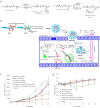Advances in drug delivery system for platinum agents based combination therapy
- PMID: 26779373
- PMCID: PMC4706518
- DOI: 10.7497/j.issn.2095-3941.2015.0063
Advances in drug delivery system for platinum agents based combination therapy
Abstract
Platinum-based anticancer agents are widely used as first-line drugs in cancer chemotherapy for various solid tumors. However, great side effects and occurrence of resistance remain as the major drawbacks for almost all the platinum drugs developed. To conquer these problems, new strategies should be adopted for platinum drug based chemotherapy. Modern nanotechnology has been widely employed in the delivery of various therapeutics and diagnostic. It provides the possibility of targeted delivery of a certain anticancer drug to the tumor site, which could minimize toxicity and optimize the drug efficacy. Here, in this review, we focused on the recent progress in polymer based drug delivery systems for platinum-based combination therapy.
Keywords: Cancer; combination therapy; drug delivery; platinum.
Conflict of interest statement
No potential conflicts of interest are disclosed.
Figures





References
-
- Available online: http://www.nccn.org/
-
- Abu-Surrah AS, Kettunen M. Platinum group antitumor chemistry: design and development of new anticancer drugs complementary to cisplatin. Curr Med Chem 2006;13:1337-1357. - PubMed
-
- Chaney SG, Campbell SL, Bassett E, Wu Y. Recognition and processing of cisplatin- and oxaliplatin-DNA adducts. Crit Rev Oncol Hematol 2005;53:3-11. - PubMed
-
- Jamieson ER, Lippard SJ. Structure, recognition, and processing of cisplatin-DNA adducts. Chem Rev 1999;99:2467-2498. - PubMed
Publication types
LinkOut - more resources
Full Text Sources
Other Literature Sources
